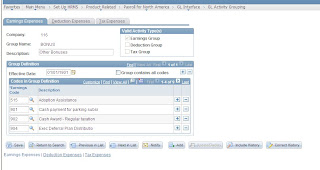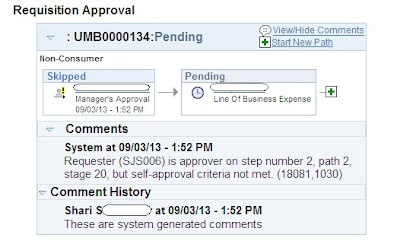- (Optional) Specify the invoice prefix on the Installation Table (INSTALLATION_TBL) - Product Specific page.
The character you put in the AP Inv. Prefix field is used as a prefix on all invoices coming from PeopleSoft HCM.
- Specify payroll tax extraction on the Company (COMPANY_TABLE) - Default Settings page.
Select the Pay Taxes through AP check box if you plan to use the interface with Payables to extract payroll taxes.
- Define general and benefit deductions.
For both general and benefit deductions, you must define when each deduction is to be paid. For example, you might want Payables to pay some deductions every time they are calculated and pay other deductions only when the goal balance has been met.
- Define vendors in Payables and publish them to the PeopleSoft HCM database.
Service OperationDescriptionVENDOR_FULLSYNCPayables publishes complete data from the VENDOR and related tables and Payroll for North America subscribes.VENDOR_SYNCPayables publishes incremental update data from the VENDOR and related tables and Payroll for North America subscribes.VOUCHER_BUILDPayroll for North America publishes data to the VOUCHER, VOUCHER_LINE, and DISTRIB_LINE tables and Payables subscribes. - Link deduction definitions to vendors and define when deductions are to be paid.
All deductions to be paid by Payables must be linked to a vendor.- To link nontax deductions (benefits, general deductions, garnishments) to vendors, complete the SetID and Vendor ID fields on the Benefit Plan Table page, Garnishment Spec Data 2 page, and General Deduction Table page.
- To determine which deductions to retrieve for Payables, use the Pay Mode and AP Payment Date Type fields on the Benefit Plan Table page, Garnishment Spec Data 7 page, and General Deduction Table page.
The Garnishment Spec Data 7 page also includes a Separate AP Payment check box that you use to control whether to generate separate checks when there are multiple garnishments for the same vendor. - To link U.S. tax deductions to vendors:
Use the Tax Type Table page to define the tax types paid to a vendor
Link each tax type to the appropriate vendor and tax classes on the AP State Tax Types/Classes Table page or the AP Local Tax Types/Classes page. - To link Canadian tax deductions to vendors, use the Canadian Tax Type Table page.
- Set up ChartFields for the GL (general ledger) interface.
If your organization uses noncommitment accounting, set up the grouping and mapping of expense ChartField for PeopleSoft GL (General Ledger) Interface
Friday, September 27, 2013
Integrating PeopleSoft HCM 9.1 with PeopleSoft AP (Non-Commit Accounting)
Tuesday, September 24, 2013
Auto Save in ePerformance
I just got a request to add auto save to ePerformance and after about 30 minutes of searching a I found this thread on the OTN Community Website.
https://forums.oracle.com/thread/2223522
But the javascript was pretty simple and worked well.
<input type="hidden" name="AUTOSAVE" value=""/>
<script type="text/javascript">
threadLock = false;
function user_function()
{
//alert('starting process');
var changes = checkFormChanged(document.%formname);
if (changes && !threadLock)
{
threadLock = true;
if ("%page" == "EP_APPR_MAIN1" || "%page" == "EP_APPR_BASE1")
{
submitAction_%Formname(document.%Formname,"EP_BTN_LINK_WRK_EP_STORE_PB");
}
}
}
window.setInterval("user_function()",15000);
Thanks to whoever left this thread!
https://forums.oracle.com/thread/2223522
But the javascript was pretty simple and worked well.
<input type="hidden" name="AUTOSAVE" value=""/>
<script type="text/javascript">
threadLock = false;
function user_function()
{
//alert('starting process');
var changes = checkFormChanged(document.%formname);
if (changes && !threadLock)
{
threadLock = true;
if ("%page" == "EP_APPR_MAIN1" || "%page" == "EP_APPR_BASE1")
{
submitAction_%Formname(document.%Formname,"EP_BTN_LINK_WRK_EP_STORE_PB");
}
}
}
window.setInterval("user_function()",15000);
Thanks to whoever left this thread!
Monday, September 9, 2013
Integrating PeopleSoft HCM 9.1 with PeopleSoft GL (Non-Commit Accounting)
We implemented both PeopleSoft FIN and HCM back in 2011, and one of the things we wanted to utilize was the integration between PeopleSoft Payroll NA and PeopleSoft GL. However, there was a lot of confusion on how this integration worked and what need to be done to accomplish it. The consultant's that we hired had never setup the integration completely and recommended that we customize the PAYGL01 to populate the chartfield values on the hr accounting line based on the employee's job record. This worked fine, but it limited our organization's ability to track chartfield values below the department level and it prevented the Payroll to AP integration from working, since the chartfield values where not getting populated on the liability tables only the accouting line. It also created some posting issues, since we never knew if the chartfield values we populated where valid until we posted them in FIN!
In summary, we took a quick fix approach to get us live on PeopleSoft, that we knew we would have to readdress later. When later finally came, we discovered that the process for setting up the integration was not that difficult after all! Here are the steps to setup Payroll Integration between and GL.
A. When building Combination Data in FIN publish process groups to HCM
B. Load Combination Code Table in HCM
Now you are ready to send Payroll to GL.
In summary, we took a quick fix approach to get us live on PeopleSoft, that we knew we would have to readdress later. When later finally came, we discovered that the process for setting up the integration was not that difficult after all! Here are the steps to setup Payroll Integration between and GL.
1. Configure Integration Broker and sync the data between your systems.
Service Operation
|
Description
|
RELEASE_REQUEST
|
HRMS requests an update of the
General Ledger version from Financials.
|
RELEASE_RESPONSE
|
HRMS receives the update of the
General Ledger version from Financials.
|
FSCM_CF_CONFIG
|
HRMS receives the specific
ChartField configuration template from Financials.
|
One integration point for each GL
ChartField
|
HRMS receives the ChartField values
published from the Financials database.
See Entering and Maintaining ChartField
Values.
|
HR_ACCT_CD_LOAD
|
HRMS receives the combination codes
imported from the Financials database or flat file and populates the GL
Account Code table (GL_ACCT_CD_TBL).
|
HR_CHARTFLD_COMBO_SYNC
|
HRMS receives the service operation
published by the Financials database to keep the Speed Type table up to date.
|
COMBO_CF_EDIT_REQUEST
|
HRMS sends a request to the
Financials database (8.4.01 or higher version) to validate a combination
code.
|
COMBO_CF_EDIT_REPLY
|
HRMS receives and processes the
response from the Financials database to a request for validation
|
BUS_UNIT_GL_FULLSYNC
|
Financials database initial full table publish of GL business
unit IDs.
|
BUS_UNIT_GL_SYNC
|
Financials database ongoing incremental publish of GL
business unit IDs.
|
BUS_UNIT_FS_FULLSYNC
|
Financials database initial full table publish of GL business
unit descriptions
|
BUS_UNIT_FS_SYNC
|
Financials database ongoing incremental publish of GL
business unit descriptions
|
JOURNAL_GEN_APPL_ID_FULLSYNC
|
Financials database initial full table publish of PeopleSoft
Journal Generator templates
|
JOURNAL_GENERATOR_APPL_ID_SYNC
|
Financials database ongoing incremental publish of PeopleSoft
Journal Generator templates.
|
PAYROLL_ACCTG_TRANSACTION
|
PeopleSoft HCM database batch publish of HR (payroll)
accounting lines.
|
2. Associate a GL/AP Buiness Unit to your HR Business Units
3. GL/HR Business Unit Mapping- Associate a Journal Template to your Business Unit.
4. Turn on the General Ledger option on the HCM Installation Record
5. On the Product Specific Tab on the HCM Intall press the Update Version button in the General Ledger Group box
6. Publish Chartfield Data from Finance to HCM
A. When building Combination Data in FIN publish process groups to HCM
B. Load Combination Code Table in HCM
7. Create GL Activity Groups
8. Map your Expenses.
Now you are ready to send Payroll to GL.
Tuesday, September 3, 2013
Adding User Comments to AWE Approval Status Monitor
Want to allow AWE Approvers to add comments to the transaction that would show up within the Approval Monitor?
This is how I approached it. First I looked in the EOAW_CORE:ApprovalEventHandler for the word "comment" and I found where the delivered code inserts comments using the Thread class, then I examined the thread methods and founds two promising methods.
method AddComments(&username As string, &comments As string);
method AddCommentsHistory(&username As string, &comments As string, &history As string);
First I started with the AddComments method, but this only appeared to show the last comments in the monitor, and we wanted to show the comment history. Maybe that is why the second method is called AddCommentsHistory?
So I Called this Method from my event handlers and it worked the way I expected, allowing me to add comments, while preserving the comment history. However, it created a new comment area within the Approval Status Monitor call "Comment History".
Within my Registered Event Handlers I added two private methods to handle getting the current approver's comments and calling the delivered thread method to store the comments.
method getComments
/+ &thread as EOAW_CORE:ENGINE:Thread +/
/+ Returns String +/
Local string &comments;
If %Component = Component.ZZ_REQUISITIONS Or
%Component = Component.ZZ_ADM_REQUISITION Then
&comments = ZZ_BR_APPR_WRK.COMMENTS.Value;
ZZ_BR_APPR_WRK.COMMENTS.Value = "";
End-If;
Return &comments;
end-method;
method addComments
/+ &thread as EOAW_CORE:ENGINE:Thread +/
Local string &userName;
Local string &checkComments;
Local ZZ_UTILITIES:getUserName &getName;
rem call local utility to return user name for addCommentsHistory;
&getName = create ZZ_UTILITIES:getUserName();
&userName = &getName.getUserNamebyOprid(%OperatorId);
&checkComments = %This.getComments(&thread);
If All(&checkComments) Then
&thread.AddCommentsHistory(&userName, &checkComments, &thread.getHistory());
End-If;
end-method;
Then I just added the following code to the OnStepComplete, OnHeaderDeny and the OnProcessLaunch.
%This.addComments(&thread);
This is how I approached it. First I looked in the EOAW_CORE:ApprovalEventHandler for the word "comment" and I found where the delivered code inserts comments using the Thread class, then I examined the thread methods and founds two promising methods.
method AddComments(&username As string, &comments As string);
method AddCommentsHistory(&username As string, &comments As string, &history As string);
First I started with the AddComments method, but this only appeared to show the last comments in the monitor, and we wanted to show the comment history. Maybe that is why the second method is called AddCommentsHistory?
So I Called this Method from my event handlers and it worked the way I expected, allowing me to add comments, while preserving the comment history. However, it created a new comment area within the Approval Status Monitor call "Comment History".
Within my Registered Event Handlers I added two private methods to handle getting the current approver's comments and calling the delivered thread method to store the comments.
method getComments
/+ &thread as EOAW_CORE:ENGINE:Thread +/
/+ Returns String +/
Local string &comments;
If %Component = Component.ZZ_REQUISITIONS Or
%Component = Component.ZZ_ADM_REQUISITION Then
&comments = ZZ_BR_APPR_WRK.COMMENTS.Value;
ZZ_BR_APPR_WRK.COMMENTS.Value = "";
End-If;
Return &comments;
end-method;
method addComments
/+ &thread as EOAW_CORE:ENGINE:Thread +/
Local string &userName;
Local string &checkComments;
Local ZZ_UTILITIES:getUserName &getName;
rem call local utility to return user name for addCommentsHistory;
&getName = create ZZ_UTILITIES:getUserName();
&userName = &getName.getUserNamebyOprid(%OperatorId);
&checkComments = %This.getComments(&thread);
If All(&checkComments) Then
&thread.AddCommentsHistory(&userName, &checkComments, &thread.getHistory());
End-If;
end-method;
Then I just added the following code to the OnStepComplete, OnHeaderDeny and the OnProcessLaunch.
%This.addComments(&thread);
Subscribe to:
Comments (Atom)











